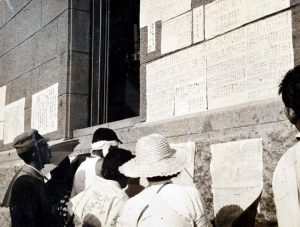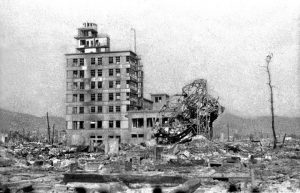Documenting Hiroshima of 1945: Around August 12, government’s letter of protest, including phrase “crime against human culture,” carried in newspaper
Aug. 12, 2024
by Kyosuke Mizukawa, Senior Staff Writer, and Minami Yamashita, Staff Writer
A photograph shows people gathered around lists of the wounded admitted to relief stations posted on the exterior wall of the Hiroshima branch of Sumitomo Bank. The burned-out building, located in the area of Kamiya-cho (in the city’s present-day Naka Ward) around 260 meters southeast of the hypocenter, survived the atomic bombing. The Chugoku Shimbun newspaper dated August 12, 1945, also appears in the photo, which was taken by Yotsugi Kawahara, a member of the photography team of the Army’s Shipping Command who died in 1972 at the age of 42. The newspaper carried a written protest submitted by Japan’s national government to the United States on August 10 in response to the attack using a “new type of bomb.”
The letter of protest stated to the effect that combatants and non-combatants, men and women, young and old were indiscriminately killed and wounded by the A-bomb blast and radiant heat, and that the use of that bomb was a “crime against human culture.”
The page of the newspaper posted on the wall was printed by the Asahi Shimbun’s West Headquarters. The Chugoku Shimbun’s head office was located in the area of Kaminagarekawa-cho (in Hiroshima’s present-day Naka Ward), around 900 meters from the hypocenter. On August 6, 1945, the interior of the company’s reinforced, ferroconcrete building was burned out, and the company had to halt its printing of its own newspaper. Many of its employees who had been mobilized as members of the Volunteer Army Corps were killed while carrying out the work of demolishing houses for the creation of firebreaks.
Use of term “atomic bombing” prohibited
On August 7, the newspaper’s reporters who experienced the atomic bombing formed an oral communication team (in Japanese, ‘Kudentai’). In the 1953 Rekishi-no-Shuen (in English, ‘The end of history’), a personal account written by Haruo Oshita, the page editor who died in 1989 at the age of 86, he described the reporters verbally conveying information about “the locations of temporary relief stations for wounded people and relief food” in order to “prevent unrest among the people.”
Police ordered that, “the term atomic bomb must not be used.” Even after the United Stated announced it had dropped an atomic bomb, the Japanese military insisted on its “opposition to causing a strong psychological shock to the public from the standpoint of leading the war,” and the government’s policy was to use the phrase “new type of bomb.” That information is based on the 1948 report Shusenki (‘Account of the end of the war’), written by Kainan Shimomura (real name: Hiroshi Shimomura), who served as Japan’s State Minister and Director of the Information Bureau.
Based on a request for cooperation from the Chugoku Shimbun, the Osaka branches and west headquarters of the Asahi Shimbun and Mainichi Shimbun printed newspapers for the company with the title “The Chugoku Shimbun” and sent them to the Chugoku Shimbun starting on August 9. The company put up the newspapers on the wall of its burned-out building. The phrase “new type of bomb” was used in both the headlines and the articles.
Meanwhile, on August 10, a Japanese Imperial General Headquarters survey team held a joint Army-Navy study group meeting in the city where a “decision” was reached concluding that “the weapon is confirmed to have been an atomic bomb.” Among other individuals, Yoshio Nishina, an atomic physicist, was involved in the investigation.
The Hiroshima Bombing Investigation Report, dated August 10, includes one of the reasons for the decision made at the meeting. It indicated that, “the soil and sand in the vicinity of the city center had been emitting radiation, and there were some people with remarkably low white blood cell counts deemed to have been an effect from radiation.”
The atomic bombing took people’s lives with a combination of thermal rays, blast, and radiation. The death toll continued to rise.
Many employees’ lives lost
On August 10, 1945, Naoko Kurokawa, 92, a resident of Hiroshima’s Nishi Ward, met her father, Kazuo Kitayama, 40 at the time, in the village of Kamisugi (in present-day Miyoshi City, Hiroshima Prefecture), where she had been evacuated. “Although he was unable to walk, he did not have burns and seemed to be in relatively good health,” said Ms. Kurokawa. Mr. Kitayama had been head of the second company of the Chugoku Shimbun Volunteer Citizens’ Corps and was supervising building-demolition work for the creation of firebreaks in the Kako-machi area (in Hiroshima’s present-day Naka Ward) when he experienced the atomic bombing.
Mr. Kitayama was carried on a two-wheeled cart to a relief station near the village office. Ms. Kurokawa said that, three days later, on August 13, “In the morning, my father and I were talking as he brushed his teeth. Then, his eyes spasmed a bit, and he stopped moving.” He died that day. The atomic bombing claimed the lives of 114 of the Chugoku Shimbun’s employees, or about one third of its staff.
(Originally published on August 12, 2024)
A photograph shows people gathered around lists of the wounded admitted to relief stations posted on the exterior wall of the Hiroshima branch of Sumitomo Bank. The burned-out building, located in the area of Kamiya-cho (in the city’s present-day Naka Ward) around 260 meters southeast of the hypocenter, survived the atomic bombing. The Chugoku Shimbun newspaper dated August 12, 1945, also appears in the photo, which was taken by Yotsugi Kawahara, a member of the photography team of the Army’s Shipping Command who died in 1972 at the age of 42. The newspaper carried a written protest submitted by Japan’s national government to the United States on August 10 in response to the attack using a “new type of bomb.”
The letter of protest stated to the effect that combatants and non-combatants, men and women, young and old were indiscriminately killed and wounded by the A-bomb blast and radiant heat, and that the use of that bomb was a “crime against human culture.”
The page of the newspaper posted on the wall was printed by the Asahi Shimbun’s West Headquarters. The Chugoku Shimbun’s head office was located in the area of Kaminagarekawa-cho (in Hiroshima’s present-day Naka Ward), around 900 meters from the hypocenter. On August 6, 1945, the interior of the company’s reinforced, ferroconcrete building was burned out, and the company had to halt its printing of its own newspaper. Many of its employees who had been mobilized as members of the Volunteer Army Corps were killed while carrying out the work of demolishing houses for the creation of firebreaks.
Use of term “atomic bombing” prohibited
On August 7, the newspaper’s reporters who experienced the atomic bombing formed an oral communication team (in Japanese, ‘Kudentai’). In the 1953 Rekishi-no-Shuen (in English, ‘The end of history’), a personal account written by Haruo Oshita, the page editor who died in 1989 at the age of 86, he described the reporters verbally conveying information about “the locations of temporary relief stations for wounded people and relief food” in order to “prevent unrest among the people.”
Police ordered that, “the term atomic bomb must not be used.” Even after the United Stated announced it had dropped an atomic bomb, the Japanese military insisted on its “opposition to causing a strong psychological shock to the public from the standpoint of leading the war,” and the government’s policy was to use the phrase “new type of bomb.” That information is based on the 1948 report Shusenki (‘Account of the end of the war’), written by Kainan Shimomura (real name: Hiroshi Shimomura), who served as Japan’s State Minister and Director of the Information Bureau.
Based on a request for cooperation from the Chugoku Shimbun, the Osaka branches and west headquarters of the Asahi Shimbun and Mainichi Shimbun printed newspapers for the company with the title “The Chugoku Shimbun” and sent them to the Chugoku Shimbun starting on August 9. The company put up the newspapers on the wall of its burned-out building. The phrase “new type of bomb” was used in both the headlines and the articles.
Meanwhile, on August 10, a Japanese Imperial General Headquarters survey team held a joint Army-Navy study group meeting in the city where a “decision” was reached concluding that “the weapon is confirmed to have been an atomic bomb.” Among other individuals, Yoshio Nishina, an atomic physicist, was involved in the investigation.
The Hiroshima Bombing Investigation Report, dated August 10, includes one of the reasons for the decision made at the meeting. It indicated that, “the soil and sand in the vicinity of the city center had been emitting radiation, and there were some people with remarkably low white blood cell counts deemed to have been an effect from radiation.”
The atomic bombing took people’s lives with a combination of thermal rays, blast, and radiation. The death toll continued to rise.
Many employees’ lives lost
On August 10, 1945, Naoko Kurokawa, 92, a resident of Hiroshima’s Nishi Ward, met her father, Kazuo Kitayama, 40 at the time, in the village of Kamisugi (in present-day Miyoshi City, Hiroshima Prefecture), where she had been evacuated. “Although he was unable to walk, he did not have burns and seemed to be in relatively good health,” said Ms. Kurokawa. Mr. Kitayama had been head of the second company of the Chugoku Shimbun Volunteer Citizens’ Corps and was supervising building-demolition work for the creation of firebreaks in the Kako-machi area (in Hiroshima’s present-day Naka Ward) when he experienced the atomic bombing.
Mr. Kitayama was carried on a two-wheeled cart to a relief station near the village office. Ms. Kurokawa said that, three days later, on August 13, “In the morning, my father and I were talking as he brushed his teeth. Then, his eyes spasmed a bit, and he stopped moving.” He died that day. The atomic bombing claimed the lives of 114 of the Chugoku Shimbun’s employees, or about one third of its staff.
(Originally published on August 12, 2024)









